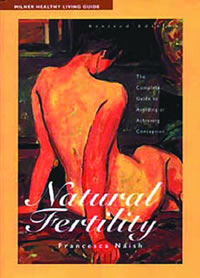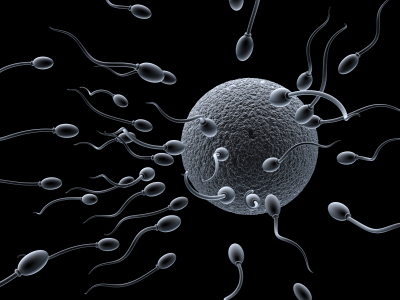How Lady Moon Can Help You Get Pregnant
An Introduction to Lunar Fertility
If you’re trying to fall pregnant, you are probably already aware that your mid-cycle or biological ovulation is the prime time to for conception to occur. What you may not be aware of, is that the moon can trigger ovulation and bring on fertility at any time during the menstrual cycle. This can sometimes result in two distinct ‘ideal conception times’.
Did you know that the word menstruation itself can be traced back to the Latin word "menses", meaning 'month', which in turn comes from 'moon', or the Greek "menus" meaning both moon and power, and "men" meaning month.
This is not a new concept. The idea that the moon in inextricably linked to women, femininity, fertility and growth has been entrenched in cultures and religions worldwide for centuries.
The waxing moon has long been believed to coincide with a period of growth for all things, while the waning moon was considered a time to harvest and prepare the ground for the next planting. The theory is not limited merely to agriculture. The effect of the moon on the breeding cycles of animals has been studied, and the sexual activity of many creatures has indeed been found to vary in relation to the moon.
In many ancient civilisations, the goddess of the moon was also the goddess of fertility or motherhood. In fact, in ancient times couples would plan intercourse to coincide with a full and bright moon, while those hoping to avoid pregnancy would wait until the moon began to wane.
Modern day advances in science and philosophy can help us understand this phenomenon and use this knowledge to our advantage.
How Can The Moon Affect Fertility?
It has been proven that exposure to light increases the levels of FSH (follicle stimulating hormone) in the hypothalamus and pituitary glands, and also that light which is absorbed through the optic nerve is used as a nutrient for the endocrine system (the part of the body responsible for the flow of hormones).

This information has been adapted from a wonderful book by Francesca Naish. In this book, she explains all about the lunar cycle and its effects on fertility. She also discusses a huge range of natural ways to control fertility. Find out more, or buy the fascinating book here: Natural Fertility.
Naturally, the fuller the moon, the more light there is beaming down on the earth during the night. Interestingly, city dwellers (who are exposed to more artificial light for long periods of time) mature sexually earlier than rural people, on average. This could potentially be due to the disruption to the natural amount of light and darkness the body is exposed to. Furthermore, women who live in the Polar Regions experience more gynaecological abnormalities, particularly during the long and very dark Arctic winter.
The moon’s gravitational pull affects all the fluids on the earth. This is most noticeable in the tides of the oceans, but the moon’s effect on fluid content in animals and plants has also been demonstrated. There is every possibility that menstruation fluids, and the liquid in which the ovum is suspended, are also affected.
The earth’s electromagnetic field changes slightly, along with position of the sun and the moon. The human body’s own electrical field has been shown to increase in voltage once a month, for 24 hours, often concurrent to ovulation. What’s intriguing is that this voltage surge also comes at time of intense agitation in mental patients, which coincidentally (or perhaps not!) occurs most often at new and full moons.
Evidently, there is a relationship between the moon, the hormones, the emotions and the nervous system. Albeit one that, as of yet, we do not fully understand.
The Natal Lunar Fertile Phase
One big believer in the power of the moon was a Czech psychiatrist called Dr Eugene Jonas. Dr Jonas re-discovered The Natal Lunar Fertile phase in the 1950s, while helping catholic women with contraception. In his attempts to find a way to for these women to manage their pregnancies with greater accuracy, Dr Jonas’s investigated the possibility that the moon could affect the reproductive function of humans, not just lower-order animals and plants.
Through much research, calculation and study he determined that a woman’s Lunar Fertile Phase was dictated by the relationship between the sun and the moon at the moment she was born. In other words, ovulation could be triggered during the time in your cycle when the moon is at the same lunar phase that it was when you were born. This ‘trigger effect’ of the moon can be increased by two factors - stress and sexual intercourse.
How to Take Advantage of the Lunar Cycle
Evidently, your Lunar Fertile Phase is completely unique to you, because it depends on your birth date. To find out what phase the moon was in on your birthday, enter your month and year of birth into this website, to produce a moon phase calender for that month: http://www.moonconnection.com/moon_phases_calendar.phtml
If you are having sex during your lunar fertile time, the chances of ovulation being triggered are increased. That is, you could get pregnant twice a month. If you are trying to fall pregnant, synchronising your cycle maximises your chance of falling pregnant at your fertile time. One way to encourage your body to sink into rhythm with the moon is through ‘Lunaception’.
Earlier in the article we mentioned that light can have an affect on the sexual organs of the body, and potentially fertility and conception. Louise Lacey, author of the book ‘Lunaception’ says “The basic theory of Lunaception is that our bodies evolved to respond to the light and dark of the moon's rhythms, menstruating at the new moon and ovulating at the full.”
The modern scientific and medical communities have difficulty coming to grips with lunar fertility theories, partly because they are based on astrology or cosmobiology and partly because the majority of our ovulation cycles, clearly, are NOT in sync with the moon. This is easily explained when you remember that today our bodies are basked in a steady amount of artificial lighting night after night. Biologically, the body can no longer differentiate between the time of a waxing moon, a full moon, or a new moon.
Mrs. Joy DeFelice, author of the paper ‘The Effects of Light On the Menstrual Cycle’ studied the effects that artificial and natural light can have on the cervical mucus patterns of women. DeFelice observed that light experienced by a woman’s body during sleeping hours could affect the hormones which govern her menstrual cycle. She found that women who experience too much light had a lack of early dry days, an extended or poor mucus pattern, as well as delayed ovulation or an inadequate luteal phase.
Louise Lacey wrote that “To reproduce that rhythm in western civilization, we must shut out all light while sleeping except in mid-month, when we add a small night light to reproduce the effects of the full moon. If your cycle doesn't match with the moon's, keep your bedroom dark until your cycle matches the moon's cycle. You will find you are likely to get into a match with the moon much more quickly that way. Then use the nightlight as above.” It usually takes 3 – 6 months for your body to adjust effectively.
Summary
Advocates of the Natal Lunar Phases and Lunaception theories emphasise that although more comprehensive scientific research could be done to provide further statistical evidence, the existence of the lunar phase phenomena cannot be ignored.
Getting in touch with your body’s lunar rhythm is a valuable, cheap and non-invasive way to increase the effectiveness of other fertility enhancement methods.
Ultimately it can give you an extra edge when trying to achieve pregnancy.
© Brisbane Fertility Clinic - All Rights Reserved.


